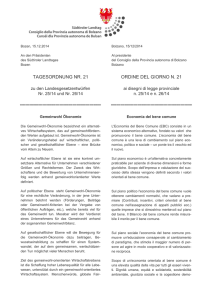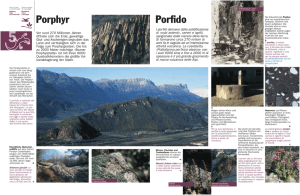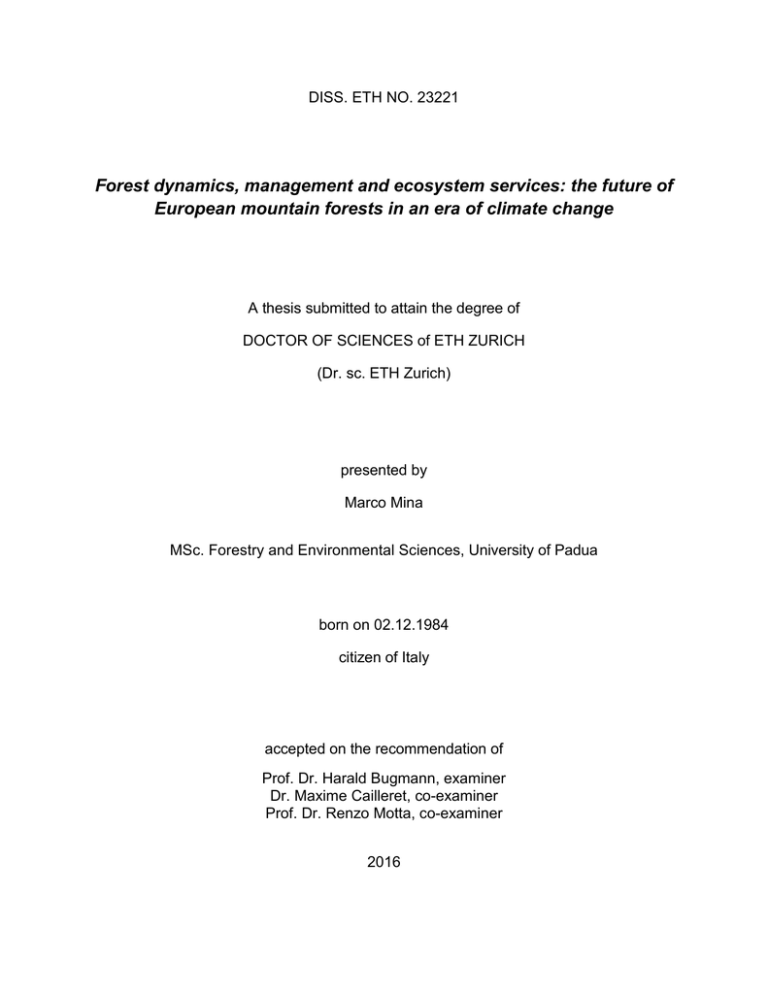
DISS. ETH NO. 23221
Forest dynamics, management and ecosystem services: the future of
European mountain forests in an era of climate change
A thesis submitted to attain the degree of
DOCTOR OF SCIENCES of ETH ZURICH
(Dr. sc. ETH Zurich)
presented by
Marco Mina
MSc. Forestry and Environmental Sciences, University of Padua
born on 02.12.1984
citizen of Italy
accepted on the recommendation of
Prof. Dr. Harald Bugmann, examiner
Dr. Maxime Cailleret, co-examiner
Prof. Dr. Renzo Motta, co-examiner
2016
Summary
In an era characterized by rapid changes of environmental, particularly climatic, and socioeconomic conditions, there is a growing need to better understand the influence of these changes
on forests and their capacity to provide key ecosystem services (ES) to human communities.
Since climate change is particularly pronounced in mountain regions, mountain forests deserve
particular attention to assess the impacts of these changes. Moreover, as forests develop slowly
over decades to many centuries, possible adaptation measures must be planned in the long term
as well, and they should be based on thorough scientific knowledge.
Dynamic vegetation models (DVMs) are often used to investigate climatic influences on
long-term forest dynamics, and more recently also to explore management impacts. Among the
many types of DVMs, forest gap models are flexible tools to analyze future forest development,
but management regimes have received little attention to date. Although these models include the
inter-specific sensitivity to the environment, intra-specific local adaptation and intra-annual variations in the environmental responses are not considered. This is especially important for capturing drought effects on growth and limits the reliability of gap models in drought-prone forests.
The overall objective of this thesis was to evaluate the potentials and limitations of current and alternative forest management strategies on the provision of multiple ES in European
mountain forests under climate change. To this end, I improved the gap model ForClim in two
respects: (1) the modeling of harvesting, and (2) the growth response to drought. I then applied
the improved model in four mountain regions across central and southern Europe.
In Chapter I, I firstly analyzed and improved the influence of crown characteristics on diameter growth in the model and implemented new harvesting functions to more accurately predict forest properties (e.g., basal area, stem number and diameter distribution) in intensively managed stands. Model performance was evaluated at ten sites in the European Alps using inventory
data, showing that analytical management algorithms (e.g., removals of basal area in relative diameter classes) should generally be preferred over empirical ones (e.g., single stem removals in
static diameter classes). I also highlighted the importance of accurately modeling management
interventions when predicting long-term forest dynamics. Secondly, future forest development
was simulated for 37 representative stands in the Dinaric Mountains under current management
and three climate scenarios. Strongly different impacts of climate change were found depending
on elevation. Low-elevation stands showed a drought-induced decrease of productivity and higher tree mortality, while stands at higher elevations profited from more favorable growing conditions. Although timber stocks will be maintained, the interacting effects of management and climate change were found to induce a strong shift in species composition, favoring broadleaves
(e.g., European beech) at the expense of the currently dominant conifers (silver fir, Norway
spruce). This indicates the need for detailed investigations on adaptive management to preserve
the conifers, as they are of high ecological and economic importance in the Dinaric Mountains.
Based on these results, in Chapter II I explored further management options for the Dinaric mountain forests. Under current climate and two transient climate change scenarios, I simulated future forest dynamics under business-as-usual and three alternative management regimes in
the same set of representative stands, including a scenario of non-intervention and an assessment
of the impact of large ungulates using different browsing pressures. Alternative management regimes would not be able to maintain current proportion of conifers in the future, although promisiii
Summary
ing management approaches were identified, such as changes in the harvesting diameters (e.g.,
retain silver firs with diameter <25 cm) and reduction of the abundance of large ungulates.
To extend the assessment over a broader range of European mountains, including
drought-prone areas, the impact of seasonal water scarcity needs to be reflected accurately in the
model. In Chapter III, I used a forward modeling approach of tree-ring growth to quantify the
intra-annual response to drought of Scots pine. Based on tree ring-width data from 16 sites along
a moisture gradient covering most of the environmental conditions of this species, I optimized
season-specific parameters capturing the level of soil moisture below which growth is not possible and the threshold above which growth is not limited by moisture. I implemented these functions in a new submodel that relates drought to growth. I found that Scots pine adapts locally to
cope with drought, and this can be included in the model to improve the local accuracy of the
simulations, albeit with a potential loss of generality. Simulations with the previous and new
model versions were compared with long-term forest inventory records from six stands in two
regions (central Spain and an inner Alpine valley). The higher performance of the new variant
suggested that ForClim – and other DVMs – should consider drought at the intra-annual scale for
simulating forest dynamics in water-limited environments. Additionally, this chapter showed the
power of model-data fusion using tree-ring data for improving or calibrating DVMs.
Chapter IV was dedicated to the application of these two model versions to project the future provision of ES by representative stands in four European mountain regions under different
climate and management scenarios. Specifically, I analyzed the trade-offs and synergies between
forest ES and evaluated their variability according to changes in climate and management. I selected 25 representative forest stands along elevation gradients in central and southern Europe:
Iberian Mountains, Western and Eastern Alps, and Dinaric Mountains. Forest development was
simulated under current climatic conditions and five transient climate change scenarios including
three management strategies: business-as-usual, non-intervention and an alternative regime. An
indicator-based approach was used to quantify the provision of four ES: timber production, carbon storage, biodiversity conservation and protection against natural hazards (rockfall and avalanches). Simulation results indicated that climate change would have very heterogeneous impacts on ES provision, depending on current stand properties and local climate. Strong impacts of
climate change were identified in all forests in the Western Alps, while Iberian Scots pine forests
showed low sensitivity. In the Eastern Alps and in the Dinaric Mountains negative impacts were
observed mainly at low elevations and only under the most severe climate projection. In general,
changes in the management had a stronger impact on ES provision than climate change. Alternative management regimes may have the capacity to increase multiple ES provision in some regions, but shifts in management must be assessed carefully, considering the contrasting effects of
climate change on forest stands along gradients of elevation and species composition.
Based on these results, I recommend that future studies that aim to assess the impacts of
climate change under different management strategies should: i) assess stand vulnerability to disturbance using a set of models that operate on different spatial scales; ii) expand the analysis to
more stands and evaluate additional management strategies; iii) quantify ecosystem services using multiple indicators or region-specific trait-based approaches; iv) explore other assessment
methodologies that consider non-linear interactions between ES. I demonstrated that DVMs are
important and useful tools to assess the impacts of anthropogenic climate change on forest dynamics. As these impacts are likely to vary strongly among and within mountain regions, future
studies should consider local and regional differences in environmental conditions and in stand
structure. The role of small-scale forest management is especially crucial in these assessments,
since its impact is likely to be more pronounced than the impact of climate change per se.
iv
Zusammenfassung
Die gegenwärtige Ära ist geprägt durch rasche Umweltveränderungen, insbesondere des
Klimas, sowie des sozioökonomischen Umfelds. Ein besseres Verständnis des Einflusses dieser
Veränderungen auf Wälder und deren Kapazität, Ökosystemdienstleistungen (ES) für die
menschliche Gemeinschaft zu erbringen ist daher unabdingbar. Da in Gebirgsregionen Klimaveränderungen besonders ausgeprägt sind, gebührt diesen spezielle Beachtung, um Auswirkungen
der Veränderungen zu erfassen. Zudem entwickeln sich Wälder langsam über Jahrzehnte bis zu
vielen Jahrhunderten, weshalb mögliche Anpassungsmassnahmen langfristig geplant werden
müssen und auf wissenschaftlich exaktem Wissen fundieren sollten.
Dynamische Vegetationsmodelle (DVMs) werden häufig für Untersuchungen von Klimaeinflüssen auf die langfristige Walddynamik gebraucht und neuerdings ebenfalls angewandt, um
Bewirtschaftungseinflüsse zu untersuchen. Unter den vielen Typen von DVMs sind Waldsukzessionsmodelle flexible Werkzeuge, um die zukünftige Waldentwicklung zu analysieren, wobei
Bewirtschaftungsformen bisher wenig Beachtung gefunden haben. Obwohl diese Modelle eine
interspezifische Umweltsensitivität miteinbeziehen, sind intraspezifische lokale Anpassungen
und intraannuelle Variationen der Umweltreaktionen nicht berücksichtigt. Dies wäre jedoch von
besonderer Wichtigkeit, um Effekte der Trockenheit auf das Wachstum zu erfassen und schränkt
deswegen die Zuverlässigkeit von Gap-Modellen in trockenheitsanfälligen Wäldern ein.
Die Zielsetzung vorliegender Doktorarbeit war die Evaluation des Potentials und der Begrenzungen aktueller und alternativer Waldbewirtschaftungsstrategien zur Erbringung vielfältiger
ES europäischer Gebirgswälder unter Einfluss des Klimawandels. Zu diesem Zweck wurde das
Gap-Modell For-Clim in zweierlei Hinsicht verbessert: (1) die Modellierung der Holzernte und
(2) die Wachstumsreaktion auf Trockenheit. Danach wurde das verbesserte Modell in vier Gebirgsregionen in Zentral- und Südeuropa angewandt.
In Kapitel 1 wurde zuerst der Einfluss von Kroneneigenschaften auf das Durchmesserwachstum im Modell analysiert und verbessert, sowie neue Erntefunktionen implementiert, um
Waldeigenschaften (z.B. Grundfläche, Stammzahl und Durchmesserverteilung) in intensiv bewirtschafteten Beständen besser prognostizieren zu können. Danach wurde das Modellverhalten
mittels Inventurdaten von zehn Standorten in den Alpen getestet. Dies zeigte, dass analytische
Bewirtschaftungsalgorithmen (z. B. Ernte von Grundfläche in relativen Durchmesserklassen)
gegenüber empirischen (z.B. Einzelstammnutzung in statischen Durchmesserklassen) generell
bevorzugt werden sollten. Für die Vorhersage der langfristigen Walddynamik ist eine exakte Modellierung von Bewirtschaftungseingriffen von zentraler Bedeutung. In einem zweiten Schritt
wurde die zukünftige Waldentwicklung für 37 repräsentative Bestände im Dinarischen Gebirge
unter aktueller Bewirtschaftung und drei Klimaszenarien simuliert. Es wurden stark unterschiedliche Auswirkungen des Klimawandels in Abhängigkeit der Höhe festgestellt. Bestände in tiefen
Lagen zeigten eine durch Trockenheit induzierte Minderung der Produktivität sowie höhere
Baummortalität während Bestände in höheren Lagen von günstigeren Wachstumsbedingungen
profitieren konnten. Obwohl die Holzvorräte erhalten blieben, verursachten die interagierenden
Effekte der Bewirtschaftung und des Klimawandels einen starken Baumartenwechsel zugunsten
der Laubholzarten wie Buche auf Kosten der momentan dominanten Nadelholzarten wie Weisstanne oder Fichte. Dies weist auf die Notwendigkeit detaillierter Untersuchungen einer adaptiv
Zusammenfassung
ven Bewirtschaftung zur Erhaltung der Nadelholzarten hin, da diese im Dinarischen Gebirge von
grosser ökologischer und ökonomischer Bedeutung sind.
Basierend auf diesen Resultaten wurden in Kapitel II weitere Bewirtschaftungsoptionen
für die Wälder des Dinarischen Gebirges untersucht. Unter dem gegenwärtigen Klima sowie zwei
Klimaveränderungsszenarien wurde die zukünftige Walddynamik unter aktueller Bewirtschaftung und drei alternativer Bewirtschaftungsstrategien für dieselbe Auswahl repräsentativer Bestände, inklusive eines Szenarios ohne Bewirtschaftung und einer Prüfung des Einflusses von
Huftieren mittels verschiedener Verbissintensitäten, simuliert. Alternative Bewirtschaftungsformen werden nicht in der Lage sein, den gegenwärtigen Anteil an Koniferen zukünftig zu erhalten.
Nichtsdestotrotz wurden vielversprechende Bewirtschaftungsansätze gefunden, wie Änderungen
in den Erntedurchmessern (z.B. Erhalt von Weisstannen mit Durchmesser <25 cm) und Reduktion der Anzahl Huftiere.
Um die Untersuchung auf einen grösseren Bereich europäischer Gebirge ausweiten zu
können, insbesondere trockenheitsanfällige Gebiete, sollte der Einfluss saisonaler Wasserknappheit im Model exakt wiederspiegelt werden. In Kapitel III wurde ein Vorwärtsmodellierungsansatz des Jahrringwachstums gewählt, um die intraannuellen Reaktionen der Waldföhre auf Trockenheit zu quantifizieren. Basierend auf Daten der Jahrringbreiten von 16 Standorten entlang
eines Feuchtigkeitsgradienten, welche den grössten Teil der Umweltbedingungen dieser Art abdecken, wurden saisonspezifische Parameter der Bodenfeuchteniveaus, unterhalb derer Wachstum nicht möglich ist sowie der Schwellenwert über dem Wachstum nicht durch Feuchtigkeit
limitiert wird, optimiert. Diese Funktionen wurden in einem neuen Submodell implementiert,
welches Trockenheit mit Wachstum verknüpft. Demnach kann sich die Waldföhre lokal anpassen, um mit der Trockenheit umgehen zu können. Dies kann im Modell zur Verbesserung der
lokalen Genauigkeit miteinbezogen werden, wodurch jedoch ein potentieller Verlust an Allgemeingültigkeit erzeugt wird. Simulationen der vorhergehenden und neuen Modellversion wurden
mit Langzeit Inventurdaten von sechs Beständen in zwei Regionen verglichen (Zentralspanien
und ein inneralpines Tal). Die höhere Leistungsfähigkeit der neuen Modellversion deutet darauf
hin, dass ForClim – und andere DVMs – Trockenheit für die Simulation der Walddynamik in
wasserlimitierten Umgebungen auf dem interannuellen Massstab berücksichtigen sollten. Zusätzlich konnte in diesem Kapitel die Stärke des Zusammenschlusses von Modell und Jahrringdaten
zur Verbesserung oder Kalibrierung von DVMs gezeigt werden.
Kapitel IV wurde der Anwendung der zwei Modellversionen zur Projektion der zukünftigen Erbringung von ES in repräsentativen Beständen vier europäischer Gebirgsregionen unter
verschiedenen Klima- und Bewirtschaftungsszenarien gewidmet. Es wurden besonders die Tradeoffs und Synergien zwischen Waldökosystemdienstleistungen analysiert und ihre Variabilität
bezüglich Veränderungen des Klimas und der Bewirtschaftung evaluiert. Entlang von Höhengradienten in Zentral- und Südeuropa wurden 25 repräsentative Bestände im Iberischem Gebirge,
den West- und Ostalpen sowie dem Dinarischen Gebirge ausgewählt. Die Waldentwicklung wurde unter gegenwärtigen klimatischen Bedingungen und fünf Klimaveränderungsszenarien sowie
drei Bewirtschaftungsstrategien (gegenwärtige Bewirtschaftung, ohne Bewirtschaftung und alternative Bewirtschaftung) simuliert. Eine auf Indikatoren basierte Vorgehensweise wurde herangezogen, um die Bereitstellung von vier ES zu quantifizieren: Holzproduktion, Kohlenstoffspeicherung, Erhalt der Biodiversität, und Schutz gegen Naturgefahren (Steinschlag und Lawinen). Simulationsresultate zeigten, dass Klimaveränderungen, abhängig von gegenwärtigen Bestandeseigenschaften und lokalem Klima, sehr heterogene Auswirkungen auf die Bereitstellung von ES
haben werden. Starke Auswirkungen der Klimaveränderung wurden für alle Wälder der Westalpen prognostiziert, während Iberische Waldföhrenwälder kleine Sensitivität zeigten. In den Ostvi
Zusammenfassung
alpen und dem Dinarischen Gebirge wurden negative Auswirkungen vorwiegend in tiefen Lagen
und unter der stärksten Klimaveränderung beobachtet. Im Allgemeinen hatten Bewirtschaftungsänderungen stärkere Auswirkungen auf die Erbringung von ES als dies die Klimaveränderung
hatte. Alternative Bewirtschaftungsstrategien könnten das Potential mit sich bringen, die Erbringung vielfältiger ES in bestimmten Regionen zu erhöhen. Allerdings muss dabei der Wechsel der
Bewirtschaftung, vor dem Hintergrund verschiedenartiger Effekte der Klimaveränderung auf
Waldbestände entlang von Höhengradienten und der Artenzusammensetzung, umfassend beurteilt werden.
Basierend auf diesen Resultaten wird empfohlen, dass zukünftige Studien über die Auswirkungen der Klimaveränderung unter verschiedenen Bewirtschaftungsstrategien, folgende
Punkte berücksichtigen: i) Beurteilung der Bestandesempfindlichkeit gegenüber Störungen mittels einem Set von Modellen, die verschiedene räumliche Massstäbe berücksichtigen; ii) Ausweitung der Analyse auf eine grössere Anzahl an Beständen und zusätzliche Untersuchung der Bewirtschaftungsstrategien; iii) Quantifizierung von Ökosystemdienstleistungen mittels vielfältiger
Indikatoren oder regionsspezifischer und merkmalbasierter Ansätze; iv) Erkundung anderer Bewertungsmethoden mit Berücksichtigung nichtlinearer Interaktionen zwischen ES. Die Doktorarbeit zeigte, dass DVMs sehr wichtige und nützliche Instrumente darstellen, um die Auswirkungen
anthropogener Klimaveränderung auf die Walddynamik zu untersuchen. Weil diese Auswirkungen zwischen und innerhalb von Gebirgsregionen normalerweise stark variieren, sollten zukünftige Studien lokale und regionale Unterschiede der Umweltbedingungen und Bestandesstrukturen
berücksichtigen. Die Rolle von kleinräumiger Waldbewirtschaftung ist besonders entscheidend in
diesen Untersuchungen, da ihr Einfluss höchstwahrscheinlich ausgeprägter ist als die Auswirkungen der Klimaveränderung per se.
vii
Riassunto
In quest’epoca caratterizzata da rapidi cambiamenti climatici e socio-economici, c’è una crescente urgenza di analizzare i possibili effetti di questi mutamenti sugli ecosistemi forestali e sulla
capacità di questi ultimi di fornire beni e servizi essenziali per la società. Poiché i cambiamenti
climatici influenzano in modo particolarmente significativo le regioni montane, le foreste di
montagna meritano particolare attenzione soprattutto nella valutazione degli impatti dovuti a
questi cambiamenti. Inoltre, poiché le dinamiche forestali si sviluppano nell’arco temporale di
decenni, se non secoli, le possibili misure di adattamento devono essere necessariamente
pianificate nel lungo periodo e basate sulla più accurata conoscenza scientifica in campo
ecologico.
I modelli ecologici a base funzionale (dynamic vegetation models; DVMs) sono ampiamente utilizzati per valutare gli impatti dei cambiamenti climatici sulle dinamiche forestali nel
lungo periodo. Tra le diverse tipologie di DVMs, i modelli forestali denominati ‘forest gap models’ sono largamente riconosciuti come strumenti scientifici appropriati e utili per analizzare lo
sviluppo futuro delle foreste. Nonostante i forest gap models permettano di analizzare la sensitività ai fattori ambientali di singole specie forestali, questi modelli non considerano in dettaglio i
regimi di gestione forestale, così come la possibilità di analizzare potenziali adattamenti intraspecifici locali e le risposte alle variazioni climatiche intra-annuali. Quest’ultimo aspetto è particolarmente importante per modellizzare gli impatti della scarsità idrica sulle dinamiche forestali,
ma allo stesso tempo limita l’applicabilità di questi modelli in ecosistemi forestali soggetti a
carenze idriche di lungo periodo.
L’obiettivo primario di questa tesi è stato quello di valutare le potenzialità e i limiti delle
attuali strategie di gestione forestale ed esaminare possibili alternative per mantenere i molteplici
beni e servizi offerti dagli ecosistemi forestali (SEF). Per questo scopo ho perfezionato due aspetti del modello ecologico ForClim: (1) la modellizzazione degli interventi di taglio forestale e (2)
gli effetti della siccità sulla crescita forestale.
Nel Capitolo I, ho dapprima analizzato l’influenza delle caratteristiche della copertura arborea sull’incremento diametrico, affinandone la simulazione all’interno del modello; successivamente ho implementato dei nuovi algoritmi per predire più accuratamente caratteristiche forestali quali area basimetrica, numero di fusti per ettaro e distribuzione diametrica in popolamenti
forestali sottoposti a frequenti interventi di gestione forestale. L’adeguatezza del modello è stata
valutata con dati di inventari forestali in dieci diversi siti nelle montagne europee. Ho potuto dimostrare che gli algoritmi basati su funzioni analitiche (ad es. rimozione di una certa percentuale
di area basimetrica in classi diametriche calcolate dinamicamente in base alla distribuzione dei
diametri simulata) sono preferibili all’uso di funzioni empiriche (ad es. la simulazione di rimozione di singoli fusti in classi diametriche statiche). Ho potuto quindi accertare l’importanza di
modellizzare accuratamente gli interventi di gestione negli studi di simulazione di dinamica forestale a lungo periodo. In secondo luogo ho simulato il futuro sviluppo di 37 popolamenti
forestali, rappresentativi delle coperture forestali delle montagne dinariche della Slovenia,
analizzando tre diversi scenari climatici e includendo le presenti pratiche di gestione forestale
(BAU, da Business-as-Usual). I risultati delle simulazioni mostrano profonde differenze in base
all’altitudine del popolamento. A basse altitudini la produttività dei popolamenti forestali in
futuro risulterebbe diminuita a causa di severi eventi siccitosi e conseguenti episodi di mortalità,
ix
Riassunto
mentre a quote più alte le crescita forestale sarebbe favorita da temperature più miti. Anche se la
quantità di produzione di legname sembra potersi mantenere a livelli attuali, le simulazioni
predicono profondi cambiamenti nella composizione delle specie arboree in conseguenza alle
pratiche di gestione forestale e agli effetti dei cambiamenti climatici. I risultati mostrano un netto
incremento in specie decidue (ad es. faggio) a discapito di conifere (tra cui abete bianco ed abete
rosso) che attualmente rappresentano le specie dominanti in queste foreste. Questi risultati
sottolineano la necessità e l’urgenza di studi dettagliati su possibili adattamenti delle presenti
pratiche di gestione forestale atte a preservare la presenza di conifere, aventi alta rilevanza sia
ecologica che econo-mica nelle foreste delle montagne dinariche in Slovenia.
Sulla base di questi ultimi risultati, nel Capitolo II ho esplorato ulteriori opzioni di gestione forestale che potrebbero essere effettuate in queste foreste, con particolare attenzione alla conservazione delle due specie di conifere. Ho effettuato un ulteriore studio di simulazione di dinamiche forestali con diversi scenari futuri, climatici (serie storica e due scenari di cambiamento
climatico), gestionali (BAU, tre regimi di gestione alternativi e uno di non-intervento) e di brucatura da ungulati (no-brucatura, medio e alto carico di ungulati). I risultati di questo studio dimostrano che i regimi di gestione alternativi non sembrano essere in grado di riuscire a mantenere le
presenti proporzioni di conifere in questi popolamenti forestali, anche se è stato possibile identificare alcuni approcci promettenti, come per esempio la ritenzione di abeti bianchi con diametro <
25 cm e una rilevante riduzione della presenza di ungulati, avente un impatto notevole sulla
rinnovazione naturale.
Per poter estendere l’applicabilità di ForClim ad ulteriori zone biogeografiche del continente Europeo, in particolare a foreste minacciate da sempre più estesi periodi siccitosi, era necessario migliorare il sottomodello che permette di valutare l’influenza della carenza idrica sulla
crescita degli alberi simulati. Nel Capitolo III ho quindi utilizzato un approccio basato sulla modellizzazione degli anelli legnosi per quantificare la risposta intra-annuale alla siccità in foreste di
pino silvestre. Una serie di parametri stagionali rappresentanti le soglie di disponibilità idrica
sopra/sotto delle quali la crescita della specie è ottimale/prevenuta, è stata ottimizzata in 16 siti
comprendenti un largo gradiente delle condizioni di crescita della specie e in cui cronologie di
anelli legnosi erano disponibili da diverse fonti. Questi parametri sono poi stati utilizzati in una
nuova versione di ForClim per simulare più accuratamente l’impatto della carenza idrica sulla
crescita forestale, potendo dimostrare che popolamenti di pino silvestre si adattano a livello locale per contrastare prolungati periodi siccitosi. Questi adattamenti possono essere implementati in
modelli ecologici a base funzionale tramite l’uso di specifici parametri, anche se questo potrebbe
compromettere il loro utilizzo ad ampia scala (perdita di generalità). I risultati di simulazione con
le due diverse versioni di ForClim sono stati comparati a dati inventariali in sei siti forestali in
due diverse aree biogeografiche (Spagna centrale e Alpi centrali). La più alta performance della
nuova versione del modello suggerisce che modelli come ForClim, e DVMs in generale, dovrebbero considerare l’influenza della scarsità idrica a scala intra-annuale, soprattutto se applicati in
ambienti in cui la siccità è un fattore chiave nella crescita e nello sviluppo forestale. Inoltre, questo studio ha permesso di dimostrare che i dati ottenuti da anelli legnosi possono essere molto
utili per calibrare e migliorare processi e simulazioni in modelli ecologici a base funzionale.
Il Capitolo IV è dedicato all’applicazione delle due versioni di ForClim per simulare future provvigioni dei SEF in popolamenti rappresentativi di quattro regioni montane in Europa. Sinergie e trade-offs tra i diversi SEF sono stati analizzati e la loro variabilità è stata valutata in
relazione a diversi scenari climatici e di gestione forestale. Un totale di 25 popolamenti forestali
sono stati selezionati lungo gradienti vegetazionali e climatici nelle montagne dell’Europa meridionale e centrale (Sistema centrale Iberico, Alpi occidentali e orientali, Montagne Dinariche). La
dinamica forestale è stata simulata utilizzando serie climatiche storiche e cinque diversi scenari di
x
Riassunto
cambiamento climatico, mentre gli scenari di gestione forestale includevano BAU, uno scenario
di non intervento e un regime alternativo. Un approccio basato su diversi indicatori è stato utilizzato per quantificare la provvigione di quattro principali SEF: produzione di legname, stoccaggio
di carbonio, conservazione della biodiversità e protezione da caduta massi e valanghe.
I risultati delle simulazioni indicano un impatto molto eterogeneo dei cambiamenti climatici sulla
provvigione dei diversi SEF, in relazione alle presenti strutture dei popolamenti e al clima a livello locale. I maggiori impatti del cambiamento climatico sono stati identificati in tutti i popolamenti forestali nelle Alpi occidentali, mentre le foreste di pino silvestre nelle montagne del Sistema centrale Iberico sembrano essere caratterizzati da una minore sensitività. Nelle Alpi orientali e nelle foreste delle montagne Dinariche, invece, impatti negativi sono stati riscontrati solamente nei popolamenti a basse altitudini e in relazione allo scenario di cambiamento climatico di
maggior severità. In generale questo studio ha permesso di constatare che cambiamenti dei regimi
di gestione avrebbero un maggior impatto sui SEF rispetto agli effetti diretti del cambiamento
climatico. Regimi di gestione alternativi potrebbero avere la capacità di incrementare la provvigione di molteplici SEF, ma modifiche alla gestione forestale devono essere valutate attentamente
tenendo conto degli effetti contrastanti del cambiamento climatico sulle assai dissimili foreste
delle montagne europee.
Sulla base di questi risultati, è dunque possibile raccomandare che studi futuri di valutazione degli impatti del cambiamento climatico sotto diversi sistemi di gestione forestale dovrebbero: i) valutare la vulnerabilità ai diversi disturbi naturali (ad es. schianti da vento, infestazioni
di insetti) utilizzando differenti modelli che operano a diverse scale spaziali; ii) ampliare l’analisi
ad ulteriori popolamenti forestali e valutare l’impatto di altre tipologie di regime di gestione; iii)
quantificare i SEF utilizzando molteplici indicatori e approcci specifici sviluppati a scala
regionale; iv) esplorare diverse metodologie di valutazione che considerino interazioni nonlineari tra SEF. Ho potuto inoltre dimostrare che i DVMs sono degli strumenti utili e importanti
per valutare gli impatti del cambiamento climatico sulle dinamiche forestali. Siccome è molto
probabile che questi impatti siano molto variabili nelle diverse zone montane in Europa, è
cruciale che studi futuri considerino le differenze delle condizioni ambientali e forestali a scala
locale e regionale. Per effettuare queste valutazioni il ruolo della gestione forestale a piccola scale
è fondamentale, dato che i suoi effetti sulle dinamiche forestali possono avere un peso maggiore
rispetto agli ef-fetti diretti del cambiamento climatico stesso.
xi

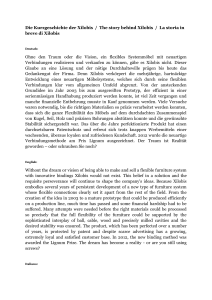
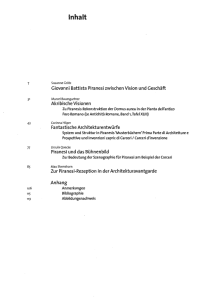

![Ricerca nr. 1 [MS WORD 395 KB]](http://s1.studylibit.com/store/data/000076742_1-2ede245e00e21c823e517529e1c3be46-300x300.png)



